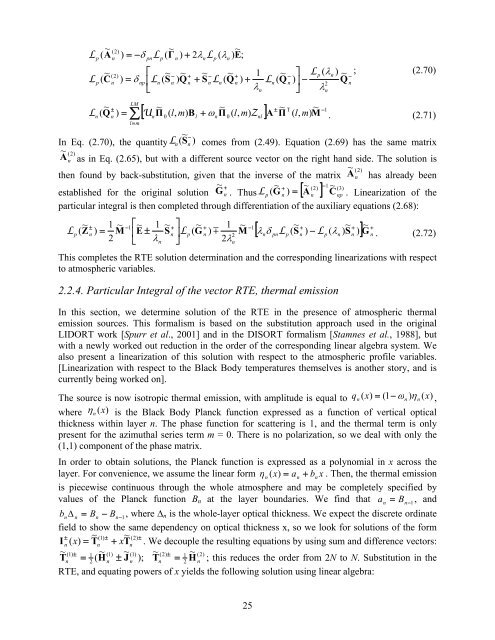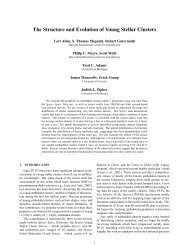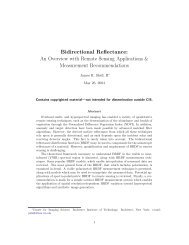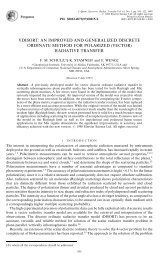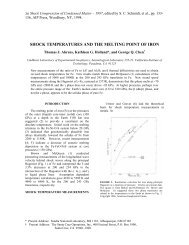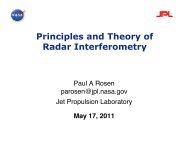VLIDORT User's Guide
VLIDORT User's Guide
VLIDORT User's Guide
Create successful ePaper yourself
Turn your PDF publications into a flip-book with our unique Google optimized e-Paper software.
~L ( Ap~L ( Cp~(2)n(2)n) = −δL) = δnppn⎡⎢L⎣np~( Γ ) + 2λL~( S−nn~) Q+nn−np~+ S L~( λ ) E;nn~( Q+n) +1Lλnn~( Q−n⎤ Lp( λn) ~) ⎥ − Q2⎦ λn~~± ~ T ~ −1[ U Π ( l,m)B Π ( l,m)Z ] A Π ( l,m)−n; (2.70)LM±Ln( Qn) = ∑ n 0l+ ωn 0nlΜ . (2.71)l=m~In Eq. (2.70), the quantity L ( − nSn) comes from (2.49). Equation (2.69) has the same matrix~A (2)n as in Eq. (2.65), but with a different source vector on the right hand side. The solution is~ (2)then found by back-substitution, given that the inverse of the matrix An has already beenestablished for the original solution G ~ + ~ + ~ 2)1(3)n . Thus [ (− ~Lp( Gn) = An] Cnp. Linearization of theparticular integral is then completed through differentiation of the auxiliary equations (2.68):~1~⎡~⎤~ + ~ + ~ +[ λ δ L ( S ) − L ( λ ) S )] G±−1++−1Lp( Zn) = M ⎢E± Sn ⎥Lp( Gn) m M2 n pn p n p n n n . (2.72)2 λn2λn⎣1~⎦~1~This completes the RTE solution determination and the corresponding linearizations with respectto atmospheric variables.2.2.4. Particular Integral of the vector RTE, thermal emissionIn this section, we determine solution of the RTE in the presence of atmospheric thermalemission sources. This formalism is based on the substitution approach used in the originalLIDORT work [Spurr et al., 2001] and in the DISORT formalism [Stamnes et al., 1988], butwith a newly worked out reduction in the order of the corresponding linear algebra system. Wealso present a linearization of this solution with respect to the atmospheric profile variables.[Linearization with respect to the Black Body temperatures themselves is another story, and iscurrently being worked on].The source is now isotropic thermal emission, with amplitude is equal to qn( x)= (1 − ωn) ηn( x),where ηn(x)is the Black Body Planck function expressed as a function of vertical opticalthickness within layer n. The phase function for scattering is 1, and the thermal term is onlypresent for the azimuthal series term m = 0. There is no polarization, so we deal with only the(1,1) component of the phase matrix.In order to obtain solutions, the Planck function is expressed as a polynomial in x across thelayer. For convenience, we assume the linear form ηn( x)= an+ bnx . Then, the thermal emissionis piecewise continuous through the whole atmosphere and may be completely specified byvalues of the Planck function B n at the layer boundaries. We find that a n= B n− 1, andbnΔn= Bn− Bn−1, where Δ n is the whole-layer optical thickness. We expect the discrete ordinatefield to show the same dependency on optical thickness x, so we look for solutions of the form± ~ 1) ± (2) ±= ( ~In( x)Tn+ xTn. We decouple the resulting equations by using sum and difference vectors:~ ( 1) ± 1~ (1) ~ (1) ~ (2) ± 1~ (2)Tn=2( Hn± Jn); Tn=2Hn; this reduces the order from 2N to N. Substitution in theRTE, and equating powers of x yields the following solution using linear algebra:25


